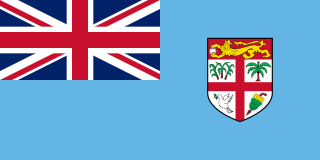Between 1879 and 1916, a total of 42 ships made 87 voyages, carrying Indian indentured labourers to Fiji. Initially the ships brought labourers from Calcutta, but from 1903 all ships except two also brought labourers from Madras and Mumbai. A total of 60,965 passengers left India but only 60,553 (including births at sea) arrived in Fiji. A total of 45,439 boarded ships in Calcutta and 15,114 in Madras. Sailing ships took, on average, seventy-three days for the trip while steamers took 30 days. The shipping companies associated with the labour trade were Nourse Line and British-India Steam Navigation Company.

An indenture is a legal contract that reflects or covers a debt or purchase obligation. It specifically refers to two types of practices: in historical usage, an indentured servant status, and in modern usage, it is an instrument used for commercial debt or real estate transaction.

Fiji, officially the Republic of Fiji, is an island country in Melanesia, part of Oceania in the South Pacific Ocean about 1,100 nautical miles northeast of New Zealand's North Island. Its closest neighbours are Vanuatu to the west, New Caledonia to the southwest, New Zealand's Kermadec Islands to the southeast, Tonga to the east, the Samoas and France's Wallis and Futuna to the northeast, and Tuvalu to the north. Fiji consists of an archipelago of more than 330 islands—of which 110 are permanently inhabited—and more than 500 islets, amounting to a total land area of about 18,300 square kilometres (7,100 sq mi). The most outlying island is Ono-i-Lau. The two major islands, Viti Levu and Vanua Levu, account for 87% of the total population of 898,760. The capital, Suva, on Viti Levu, serves as the country's principal cruise-ship port. About three-quarters of Fijians live on Viti Levu's coasts, either in Suva or in smaller urban centres such as Nadi—where tourism is the major local industry—or Lautoka, where the sugar-cane industry is paramount. Due to its terrain, the interior of Viti Levu is sparsely inhabited.

Mumbai is the capital city of the Indian state of Maharashtra. As of 2011 it is the most populous city in India with an estimated city proper population of 12.4 million. The larger Mumbai Metropolitan Region is the second most populous metropolitan area in India, with a population of 21.3 million as of 2016. Mumbai lies on the Konkan coast on the west coast of India and has a deep natural harbour. In 2008, Mumbai was named an alpha world city. It is also the wealthiest city in India, and has the highest number of millionaires and billionaires among all cities in India. Mumbai is home to three UNESCO World Heritage Sites: the Elephanta Caves, Chhatrapati Shivaji Maharaj Terminus, and the city's distinctive ensemble of Victorian and Art Deco buildings.
Contents
The most important man on these ships was the Surgeon-Superintendent, who supervised the medical care, ventilation, clothing, cleanliness and exercise of the passengers and his authority extended over the Captain. He inspected the stores before departure and reported on any defects during the trip. The Surgeon-Superintendent also intervened to prevent passengers from being mistreated by the crew. He was paid a bonus for each labourer landed alive.
